| 1 | A lazy Korean pitviper |
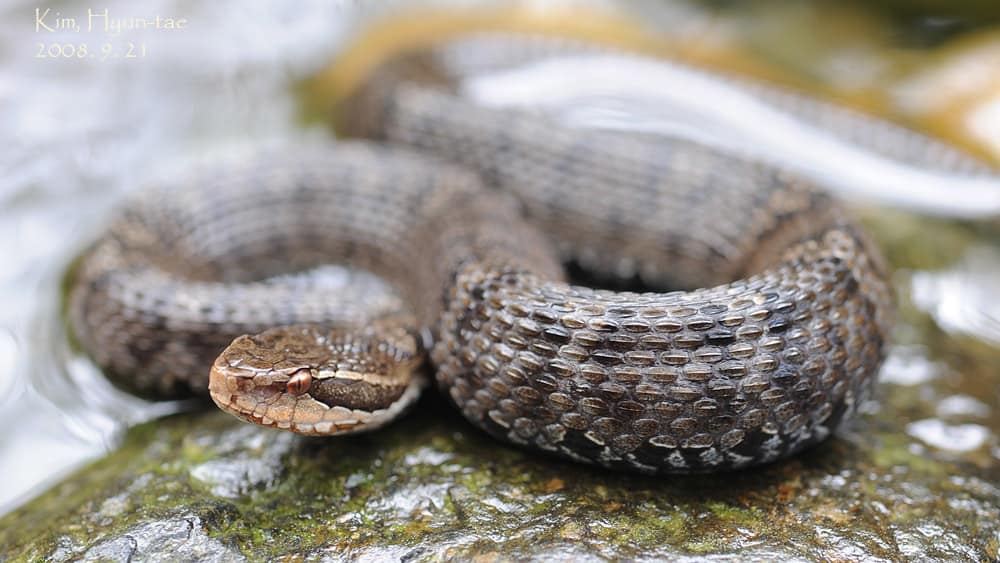
South Korea is far from a tropical nation, yet it’s a surprising hotbed of venom. The country suffers 2315-4143 snakebites each year, and according to official statistics, one species contributes the most: the Ussuri pitviper (Gloydius ussuriensis). This is one of 9 venomous snakes native to South Korea, also including its relative the short-tailed pitviper.
Ussuri pitvipers are a small snake, rarely exceeding 80cm, with an average of 50-60cm. This species has small eyes, with sharply vertical pupils, which are very difficult to make out unless you’re practically rubbing noses (which we don’t advise). Another of their names is the red-tongued pitviper, and this name is accurate, although the shade is sometimes pink instead. Ussuri pitvipers have a triangular head, which resembles the blade of an arrow shaft when viewed from above.
Ussuri pitvipers inhabit eastern Russia and northeast China, but the Korean peninsular is their undisputed stronghold, with the majority of sightings coming from South Korea (as data from North Korea is scarce these days). Ussuri pitvipers inhabit most of the country, including the volcanic Jeju island 73 kilometres off the south coast. They fail to reach Japan, where they’re replaced by their close relative the mamushi.
| 2 | Lethal in lab tests |
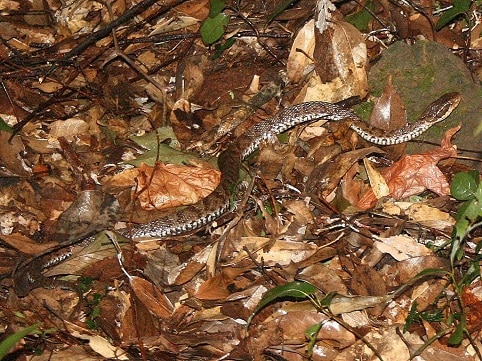
The Ussuri pitviper is the deadliest of the Gloydius pitviper members in Korea. It was compared to its Korean relatives, Gloydius saxatilis and the short-tailed pitviper, and found to have the lowest LD50 toxicity score, the quantity that kills 50% of animals injected to. Furthermore, its haemorrhaging properties were easily the strongest, allowing more blood to gush forth from gums, cuts and possibly eyes.
Ussuri pitviper venom targets all internal organs, but particularly the kidneys. It contains a cocktail of chemicals, one being a unique coagulant called calobin, first identified in 1996. This converts fibrinogen to fibrin, which forms an insoluble mass, mimicking normal human blood clotting, but taken to extreme levels, depleting clotting agents so far around the bloodstream that normal cuts don’t stand a chance.
It’s typical for Ussuri pitviper victims to experience swelling, haemorrhagic discharge, ulceration, change in skin colour, and necrosis surrounding the bite site.
| 3 | Habitat: moist forests and grassland |
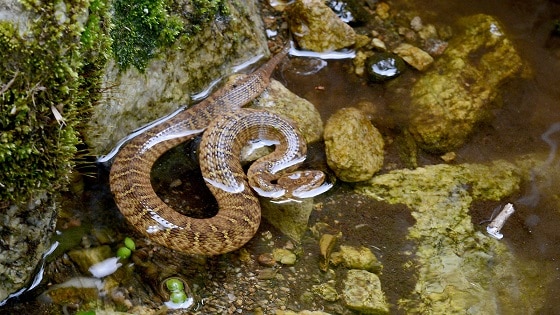
Ussuri pitvipers have several Gloydius pitviper relatives in South Korea, but these barely overlap, separating neatly into their own habitat niches. A study compared Ussuri pitvipers to the central Asian pitviper, AKA Gloydius intermedius. It found that in the Cheonma-san Mountain County Park of northwest South Korea, Ussuri pitvipers much preferred the wooded valley floors, with moistness and plenty of trees. The central Asian pitviper stuck to higher altitude areas, particularly drier areas with an abundance of sunshine.
Ussuri pitvipers also had a massive preference for canopy cover, with thick branches and leaves blocking out the sunlight from above. The study measured forest densities as percentages, and found that the vast majority preferred 60-100% cover, compared to central Asian pitvipers which only outnumbered the Ussuri pitviper in 0-20% cover. This cousin much preferred open areas.
The two species preferred their own habitat zones to such an extent that they rarely met. Both pitvipers were attracted to rocks, leaf litter, and shrubs, but Ussuri pitvipers had a stronger liking for grass, trees, and small streams overall.
| 4 | Secretly allied with insects |
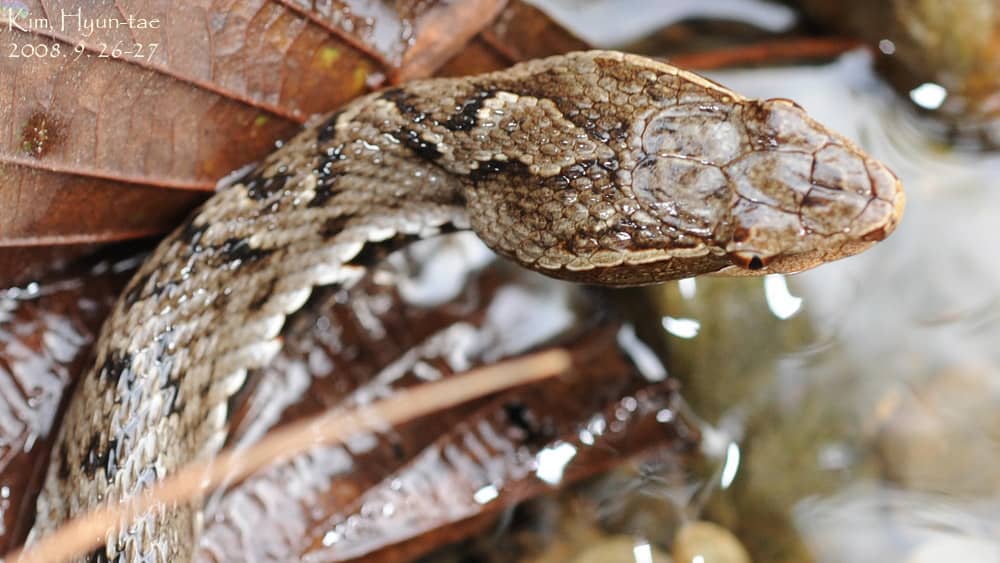
There are many cases of snakes peacefully cooperating with animals. The desert horned viper of Africa takes refuge in deep dabb lizard burrows, where the two coexist peacefully, with the snake defending the burrow entrance ferociously and thus benefitting the lizard. Ussuri pitvipers may have a symbiotic relationship with the ground beetle (Carabus granulatus), a notorious hunter of the larvae and nymphs of ticks.
In 2011, in eastern Russia, scientists were monitoring a pile of wooden boards which an Ussuri pitviper was resting beneath, near a forest homestead. They noticed a ground beetle crawling steadily along the floor, eventually climbing the snake’s scales and saddling its back. Then the beetle began investigating cracks between the pitviper’s scales, and swallowing up ectoparasites hidden there.
Even weirder, as the hungry beetle progressed, the Ussuri pitviper rotated its body, allowing its insect friend access to new scale cracks. The snake benefitted with its future freedom from parasites, while the beetle benefitted with a meal. This partnership session lasted just under 15 minutes.
| 5 | Barely moves all day |
Ussuri pitvipers are a fairly sedentary snake, paddling in their shallow streams and seeing no reason to leave. They typically stay within an area of 60 square metres, in which they can be found again and again over many months. The Ussuri pitviper by a Korean man’s favourite forest stream could be the same one that terrified him last year.
This 2015 study tracked a number of Ussuri pitvipers on Gapado Islet in South Korea. A group of 7 were particularly lazy, moving just 3-32 metres from the original position over 300 days. Another batch were slightly more adventurous, with one snake moving 44 metres over 35 days. This still doesn’t compare to the green whipsnake of Italy, which can move over 800 metres in one day.
Ussuri pitvipers don’t even embark on sudden summer migrations. They would rather stick to the comfy stream they know and love, rather than venturing into the big bad wild and taking an unnecessary risk. Yet the weird thing was that despite barely moving, the Ussuri pitvipers had a very low recapture rate. The scientists struggled to rediscover individuals snakes after the first sighting, perhaps because their camouflage was so effective.
| 6 | Hijacks opioid receptors |
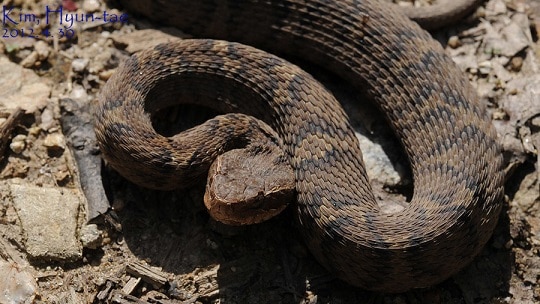
Ussuri pitviper venom is still an unknown quantity. Every species has subtle differences, with some stranger than others, and in 2007 a unique neurotoxin was identified in Ussuri pitviper called Gln49-PLA2.
When injected into mice, it produced weak anticoagulant and myotoxic (muscle-assaulting) effects. However, it also produced systemic pain, raging through the entire body, not just at the bite site. 615 mice were injected with venom, and had a noticeably lower pain threshold compared to the control group without.
This pain was successfully reversed using the drug naxalone. This is the emergency medication used in heroin or fentanyl overdoses, a name that is now familiar to many US citizens with its raging opioid epidemic. This proved that unlike other snake venoms, Gloydius ussuriensis produces its pain by manipulating opioid receptors. The Costa Rican coral snake, meanwhile, acts via acid sensing ion channels, with a toxin called MitTx. Drooping eyelids, clumsy muscle control, and drowsiness are other neurotoxic symptoms of the Ussuri pitviper.
| 7 | Diet: loves amphibians |
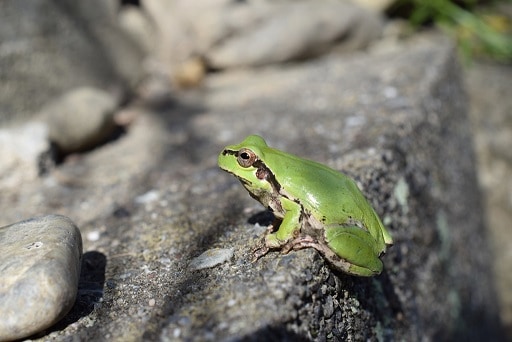
Ussuri pitvipers are fairly flexible in their eating habitats, not a snake with an ultra-narrow niche like false smooth snakes and their Iberian slow worms. However, they lean strongly towards amphibians, which correlates with their love for shallow streams near forests. A study from the volcanic Jeju Island (which has 360 mini volcanic cones) involved 177 food items from 46 Ussuri pitvipers. The breakdown was as follows: 55.2% amphibians, 20.7% mammals, 13.8% centipedes, and 10.3% reptiles.
However, they’re an adaptable species, which makes do with less appealing meals in lean circumstances. In Gapado Island, 5.5km away from Jeju Island, they were found to eat lizards and centipedes exclusively.
Many prey species have been confirmed, but one dominates all: the Japanese tree frog (Hyla japonica). This is a very green and very common species which is popular with many snake species, including tiger keelbacks in Japan’s forests. Boreal digging frogs and black spotted frogs are also confirmed prey, while their favourite centipede is the Chinese red-headed centipede. Mammal meals include Laxmann’s shrews and Korean red-backed voles.
| 8 | Destroys blood clotting |
The antivenom picture is mixed for this snake. Ussuri pitvipers lack a dedicated serum, as the main pitviper antivenom in Korea is Kovax, which is produced from Gloydius brevicauda, injected into horses to collect the antibodies. On the other hand, the Gloydius pitvipers’ toxins overlap, and Kovax works decently for Ussuri pitvipers too. The only worry is the unique haemorrhaging toxins such as calobin.
Gloydius ussuriensis also varies depending on location. In its far eastern territories, the venom was more likely to cause blood clotting by extreme depletion of clotting materials – the hyper conversion from fibrinogen to fibrin described above. But in Korea, the venom cleaved through fibrinogen directly, destroying ingredients in a simpler manner.
Ussuri pitvipers also cause moderate yet respectable destruction of Factor X (FXa). This is another step in the clotting process – it cleaves prothrombin in two in order to create thrombin, which itself converts fibrinogen to the tough fibrin which makes up the backbone of clots, and healthily congealing blood. Destroying FXa is common in haemorrhaging snakes.
| 9 | Many patterns and colours |
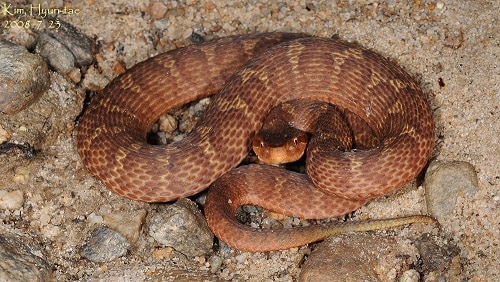
Some snakes opt for flashy neon colours that send an instant signal of lethal venom. The Ussuri pitviper opts for camouflage, with dull brown and beige alternating in many shifting shades, so that they disappear easily in fallen leaves.
However, this snake has a large variety of colours. Brown is the standard, but some are almost orange, and another batch are grey. The intensity of the blotches vary; some are sharply paler than the base, while others are murky and blend in.
A more consistent sign is two lines on the face. A thin white line starts at the top of the eye, and stretches backwards, running parallel to a black line which starts at the bottom of the eye, always running backwards towards the neck. There are also subtle white scales across the body. Ussuri pitvipers usually have a dark grey belly, but with white flecks and spots that increase in intensity as the chin approaches.
| 10 | The jet black enclave |
Overall, it’s vary rare for Ussuri pitvipers to have flashy colours, no matter how much they vary. The one exception is melanistic, fully black snakes. This was found on July 3rd 2019, on South Korea’s Jeju Island.
The black snake measured 40cm, and had just shed its skin, judging by the lack of debris between its scales. It was almost completely black, with just the faint outlines of normal patterns visible. The one exception was the signature white line starting above the eye – this was just as snowy white as ever.
Jeju island has a particularly high concentration of these pitch black Ussuri pitvipers. It’s probably down to the volcanic soil, which mostly consists of basalt rock, spewed up from the Earth’s mantle 2 million years ago (when the island first formed). Black means superior camouflage. This has happened with other species on Jeju island, such as the Oriental fire-bellied toads, which are also darker than on the South Korean mainland. Ussuri pitvipers are believed to have colonised Jeju island not long after its formation, during the early Pleistocene period, when sea levels were far lower.
